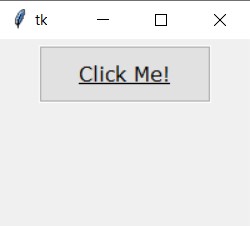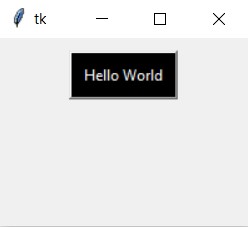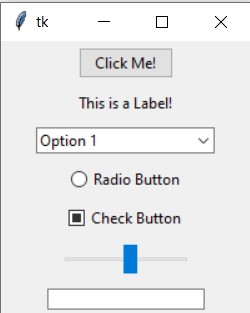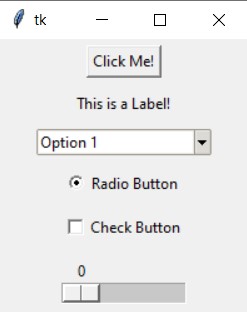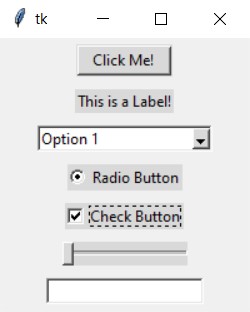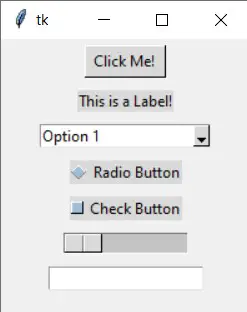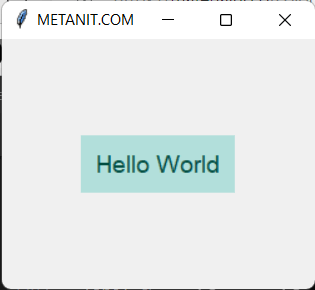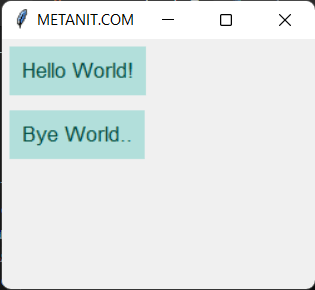Tkinter ttk Styles
The Style Class is something new introduced by ttk, in order to improve upon Tkinter, and address a common complaint against it. Tkinter keeps both it’s logic code and styling options in the same area, whereas ttk uses the Style class to separate the styling from the widget logic.
ttk also expands upon the styling concept in Tkinter, for example, allowing us to create a style once, and then apply it on many widgets without having to re-write any code.
Table of Contents:
- Creating your own ttk Style
- Using Default ttk Styles
- ttk Themes
- List of Default Styles
Creating your own ttk Style
The first thing we will do in this ttk Tutorial, is explore how to create our own styles. (Default ttk Styles will be discussed later on).
Example# 1
In this example we’ll create a custom style for a ttk Button. When creating a style, we need a name for it which we will later assign in the style option for the widget. We use the naming convention “Name” + “.” + “Default Style”. So for the Button, whose default style name is “TButton”, we could call it “Custom.TButton”.
Using the style.configure() method, we can make changes to any style and also create any style. If the style name doesn’t exist, it will be created. We can change options like foreground, background, padding etc.
import tkinter as tk import tkinter.ttk as ttk class Window: def __init__(self, master): self.master = master frame = ttk.Frame(self.master) style = ttk.Style() style.configure("Custom.TButton", foreground="black", background="white", padding=[10, 10, 10, 10], font="Verdana 12 underline") bttn = ttk.Button(frame, text="Click Me!", style="Custom.TButton") bttn.pack() frame.pack(padx = 5, pady = 5) root = tk.Tk() root.geometry("200x150") window = Window(root) root.mainloop() Now any widget we create and assign the Custom.TButton style, will have these attributes. It’s much simpler than having to rewrite the same options for each widget individually, which is what would happen in Tkinter, without ttk.
Example# 2
Let’s try another example, but for the Label instead this time.
class Window: def __init__(self, master): self.master = master frame = ttk.Frame(self.master) style = ttk.Style() style.configure("Custom.TLabel", foreground="white", background="black", padding=[10, 10, 10, 10], relief="raised") label = ttk.Label(frame, text="Hello World", style="Custom.TLabel") label.pack(padx = 5, pady = 5) frame.pack(padx = 5, pady = 5) root = tk.Tk() root.geometry("200x150") window = Window(root) root.mainloop() Refer to the bottom of this tutorial, for a complete list of default styles and their names. Also, if you end up customizing alot of your widget styles, you might want to consider defining your TTK styles in a separate file, and importing them from there.
Using Default Styles
We don’t always have to create a new style though. We have default styles as well which are enabled by default.
The below example shows a few widgets created with the default widget styles assigned to them.
import tkinter as tk import tkinter.ttk as ttk class Window: def __init__(self, master): self.master = master button = ttk.Button(self.master, text = "Click Me!") button.pack(padx = 5, pady = 5) label = ttk.Label(self.master, text = "This is a Label!") label.pack(padx = 5, pady = 5) checkbox = ttk.Combobox(self.master, values=["Option 1","Option 2"]) checkbox.set("Option 1") checkbox.pack(padx = 5, pady = 5) radiobutton = ttk.Radiobutton(self.master, text="Radio Button") radiobutton.pack(padx = 5, pady = 5) checkbutton = ttk.Checkbutton(self.master, text="Check Button") checkbutton.pack(padx = 5, pady = 5) scale = ttk.Scale(self.master, from_=0, to=10) scale.pack(padx = 5, pady = 5) entry = ttk.Entry(self.master) entry.pack(padx = 5, pady = 5) root = tk.Tk() root.geometry('200x220') window = Window(root) root.mainloop() We can see what kind of values have been assigned to the style options for a widget using the lookup() method.
style = ttk.Style() print(style.lookup("TButton", "font")) style.configure("TButton", font = "Verdana 12") print(style.lookup("TButton", "font")) The output shows the value for the “font” option, before and after we changed it for the “TButton” widget.
The names of Default Styles are pretty easy to guess. For example, the Default Style for a Button is “TButton”, and for the Label, it’s “TLabel”. For a complete list of Tkinter Default Styles and their names, refer to the table at the bottom of this tutorial.
Modifying Default Styles
Another approach you can take, is to modify Default Styles using the style.configure() method.
A benefit here is that we don’t even need to assign the style option, because by default they all have the default style for that widget equipped. Any changes we make to the default style, will automatically change the appearance of all widgets for the group.
However this is also potentially problematic, as any changes you make will effect all the widgets of that type. So the original look will be lost forever. Which is why we actually go to the bother of making Custom Styles.
ttk Themes
Themes in ttk are basically a compilation of various styles and options for all the widgets inside of it. There are a bunch of themes available to us on our systems, which we can view using the following command.
import tkinter as tk import tkinter.ttk as ttk class Window: def __init__(self, master): s = ttk.Style() print(s.theme_names()) print(s.theme_use()) root = tk.Tk() window = Window(root) root.mainloop()
('winnative', 'clam', 'alt', 'default', 'classic', 'vista', 'xpnative') vistaThe default theme for us is “vista”, however this will vary from OS to OS. The number and types of themes available will also vary from OS to OS.
This is what a tkinter ttk window with a few widgets can look like with different themes.
This is what Tkinter looks like without ttk widgets:
The Default look on windows (vista theme):
To learn more about ttk Themes, how to create, and modify them, refer to our tutorial on ttk Themes.
List of Default Styles
This marks the end of the Tkinter ttk Style tutorial. Any suggestions or contributions for CodersLegacy are more than welcome. Questions regarding the tutorial content can be asked in the comments section below.
Python ttk style configure
Стиль описывает внешний вид виджета. За установку стиля в виджетах отвечает параметр style . Встроенные виджеты по умолчанию применяют некоторые встроенные стили. В частности, все кнопки применяют стиль TButton, который описывает, как выглядят кнопки. Каждый стиль имеет имя. При создании, изменении или применении стиля к виджетам, необходимо знать его имя.
Чтобы узнать стиль определенного виджета, можно обратиться к его параметру style :
label = ttk.Label(text="Hello World") label.pack(anchor=CENTER, expand=1) print(label["style"])
Если возвращается пустая строка, то значит, что к виджету применяется стиль по умолчанию. В этом случае название стиля можно получить с помощью метода winfo_class() :
label = ttk.Label(text="Hello World") print(label.winfo_class()) # TLabel
Как правило, встроенные стили называются по имени класса виджета и предваряются буквой T. Например, для виджета Label — стиль TLabel, для Button — TButton.
Определение и применение стилей
Стиль в Tkinter представляет объект Style . У данного объект есть метод configure() , который позволяет настроить стиль
from tkinter import * from tkinter import ttk root = Tk() root.title("METANIT.COM") root.geometry("250x200") label_style = ttk.Style() label_style.configure("My.TLabel", # имя стиля font="helvetica 14", # шрифт foreground="#004D40", # цвет текста padding=10, # отступы background="#B2DFDB") # фоновый цвет label = ttk.Label(text="Hello World", style="My.TLabel") label.pack(anchor=CENTER, expand=1) root.mainloop() Здесь создается стиль в виде объекта label_style. В методе configure() первым параметром передается имя стиля — в даннои случае «My.TLabel». Все остальные параметры настраивают различные аспекты стиля, так здесь устанавливаются шрифт, цвет фона и текста и отступы.
label_style.configure("My.TLabel", # имя стиля font="helvetica 14", # шрифт foreground="#004D40", # цвет текста padding=10, # отступы background="#B2DFDB") # фоновый цвет Затем применяем этот стиль, передавая его параметру style :
label = ttk.Label(text="Hello World", style="My.TLabel")
Имена стилей
Имя создаваемых стилей имеют следующий формат:
новый_стиль.встроенный_стиль
Например, в примере выше название стиля «My.TLabel» указывает, что фактически он называется «My» и наследуется от «TLabel». И те параметры, которые не будут явным образом определены, будут унаследованы от родительского стиля «TLabel»
Расширение встроенных стилей
Вместо создания новых стилей можно просто изменить отдельные характеристики уже существующих:
from tkinter import * from tkinter import ttk root = Tk() root.title("METANIT.COM") root.geometry("250x200") ttk.Style().configure("TLabel", font="helvetica 13", foreground="#004D40", padding=8, background="#B2DFDB") ttk.Label(text="Hello World!").pack(anchor=NW, padx=6, pady=6) ttk.Label(text="Bye World..").pack(anchor=NW, padx=6, pady=6) root.mainloop() В данном случае изменяется встроенный стиль TLabel. Он применяется к меткам по умолчанию, поэтому данный стиль не надо явным образом устанавливать для меток.
Применение стиля ко всем виджетам
Выше стиль применялся к меткам Label, к другим же типам виджетов он не применялся. Если же мы хотим, чтобы у нас был бы общий стиль для всех типов виджетов, то в метод configure() в качестве имени стиля передается «.»
from tkinter import * from tkinter import ttk root = Tk() root.title("METANIT.COM") root.geometry("250x200") ttk.Style().configure(".", font="helvetica 13", foreground="#004D40", padding=8, background="#B2DFDB") ttk.Label(text="Hello World!").pack(anchor=NW, padx=6, pady=6) ttk.Button(text="Click").pack(anchor=NW, padx=6, pady=6) root.mainloop() Подобный стиль также не надо явно применять, он применяется автоматически ко всем виджетам
